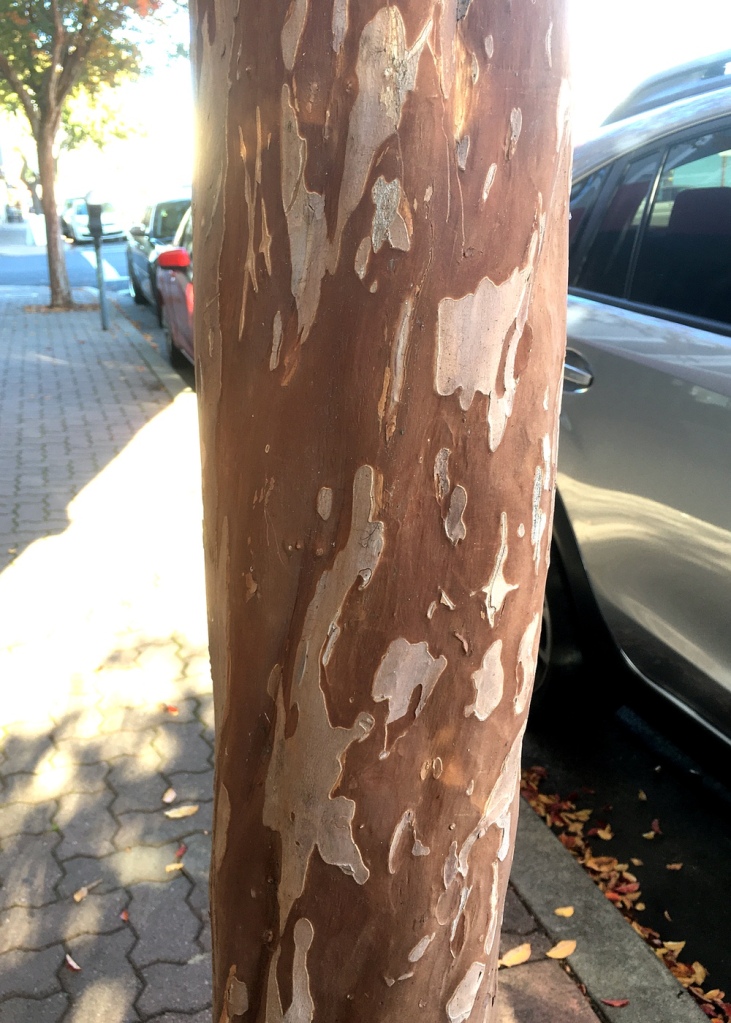
All images by Dan Gilchrist
I confess: I have an emerging fascination with tree bark, especially the unique and strangely beautiful details I can find, given appropriate time to look for them.
Surely it’s an inevitable outcome of my many years of pruning trees. But maybe it’s also my version of birdwatching—among common interests for “those of a certain age.” Slowing down to notice more details in our daily world, and growing somewhat obsessed with them. Incidentally, I’m noticing the birds more, too.
“Whoa, did you see that Townsend’s Warbler?”
“Sorry, I didn’t notice. I was distracted by the striations on the bark of that Thuja plicata.”
Now I find barkwatching makes nearly any walk way more interesting, even (or especially) in winter. There are trees with colorful bark, of course. But what first appears as a featureless gray tree trunk along a residential sidewalk often, upon closer inspection, reveals a tapestry, an intricate map, a peek into a mossy landscape—even another civilization.
My longsuffering wife has learned to wait up as I stop to pull out the phone camera for yet another closeup of yet another tree with intriguing bark patterns or other features. She sometimes points out trees that I otherwise may have missed.
There are other worlds out there. Tolkien’s ents and other literary tree characters begin to take form.



Scientifically, bark is fascinating enough. In simple terms, a tree trunk has three main components: a core of heartwood, a thin cambium layer, and the outer bark.
Between the heartwood (made of non-living, but sturdy wood tissue) and the cambium (a very active, cell-producing layer) is xylem, a layer of “pipes” which carries water and nutrients up from the roots to the rest of the tree. When the xylem tissue dies, it stiffens, adding to the heartwood and expanding the trunk. Thus, the growth rings we see on a cut cross section.
Between the cambium and outer bark is phloem, a similar pipe layer which carries sugars from the leaves (produced through photosynthesis) down to feed the roots. When phloem tissue dies, it adds to the cork, or inner bark layers.
Bark helps protect the tree from pests and environmental damage (freezing, sunlight, even fire for some species). It also provides habitat and food for a variety organisms, many of which have a symbiotic relationship with, and are beneficial to the tree’s survival. Older trees, those with multiple branch crotches and/or deeply furrowed bark, host entire ecosystems of mosses, lichens, fungi, and associated inhabitants.
Artistically, the bark of the trees along my route offers nearly infinite detail to feed my growing obsession. But it takes patience to really look, recognize the artwork, let stories emerge from these seemingly inert, blank trunks. Pay attention, look long enough, and we begin to see:
Faces
Particularly “eyes,” and prominent on our native red alders, which, to me, look astonishingly like eyes on Northwest indigenous formline art motifs. Coincidence? Among the resemblances of full faces, some look wise, some creepy, some comical.



Geometric Order
There are grids, stripes, diamonds, chevrons, hexagons, as there are in many such patterns in nature. Perhaps not precise, but with enough regularity to evoke order. Endless shapes, colors and textures to look for, as well.






Calligraphy
Marks which look like writing typically have animal or insect origins, on outer bark or exposed inner layers of bark or heartwood. Bear scratches and elk bites are easy to explain but sometimes I wonder: are the worms trying to message us in some secret, ancient language?



How we see and what we notice on a tree is strongly affected by light — intensity, direction, color. It can highlight and change our perception of texture, crevice and shadows. Some bark details are inconspicuous until lit by direct sunlight or wetted by rain.
Beautiful wood grain is certainly attractive, but I am also fascinated by dead and decaying trees and stumps. They reveal trees’ fundamental cellular structure, and the process of decomposition. And easier to watch than an animal carcass undergoing the same process.


Some of a tree’s most unique characteristics are formed by wounds — “knotholes,” scratches, scars, viral growths, cracks, and swollen tissue called “woundwood.” There are many ways a species or individual tree responds to damage or weathering. Some marks are artfully beautiful, others whimsical, other-worldly, grotesque, almost obscene; some truly bizarre.



Tree Bark & Human Skin
I see many of these responses as naturally creative acts of healing and resilience. Trees don’t heal the same way that we and our animal relatives heal. Their cells cannot rebuild damaged tissue the way ours can. Rather, they tend to seal off the damaged area and grow around it, sometimes in unexpected ways.
What might we humans learn from that? When are we able to seal off a wound or difficult experience and keep growing? Sometimes a physical or emotional wound is too significant to simply “seal off.” It takes time and support.
Although our wounds and scars may be reminders of trauma or inescapable marks for some of us, they also make us unique, make our story unique. For some, they can be statements of pride or even beauty.
We know the nurturing and healing potential of touch. Of physical contact with another living entity, be they human, animal or even a plant. Although trees don’t typically touch each other the way we do, perhaps the way their bark can serve other organisms (such as providing medicinal sources) is an example of how they touch us.
But even if the significance is only skin (or bark) deep—and not to mention all they do for our urban environment—I am not ashamed of my barkwatching habit, seeking out trees for their stories, resilience, and unexpected beauty they bring to our ordered, over-paved world.
©2023 Dan Gilchrist
